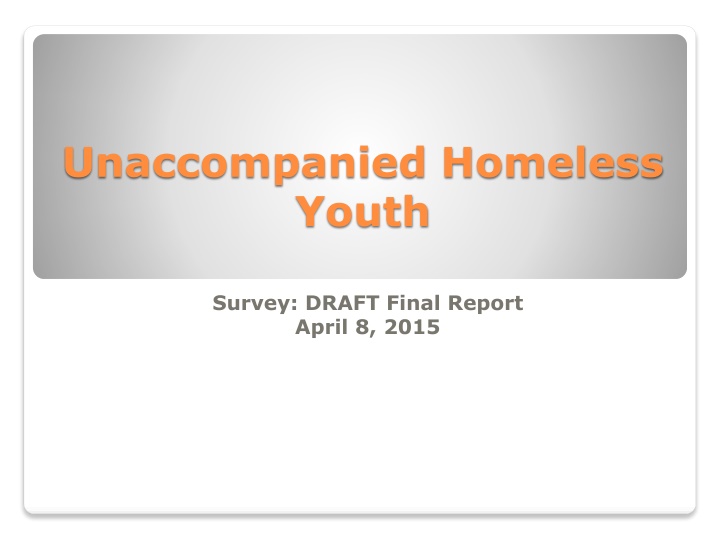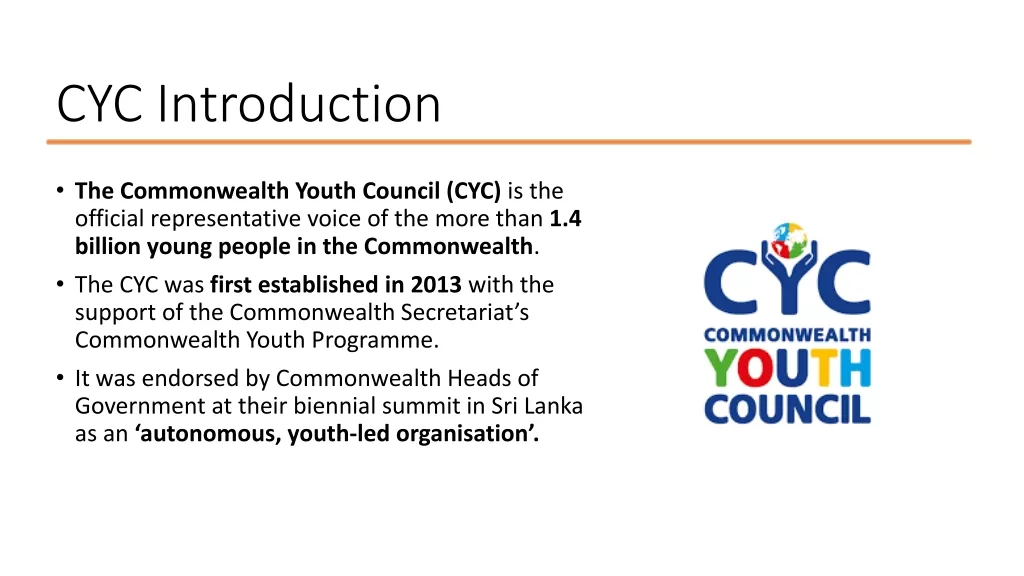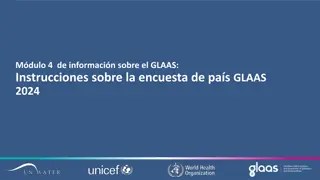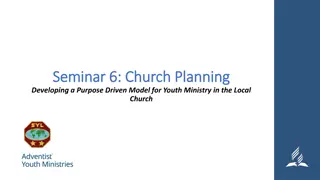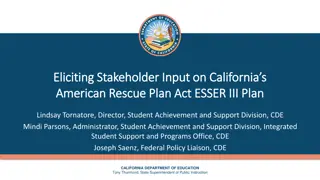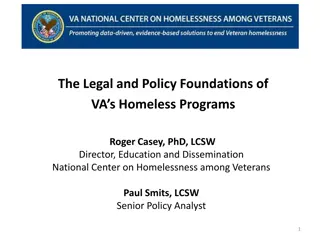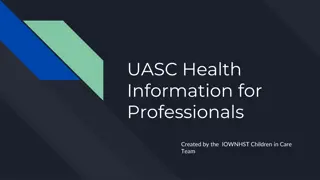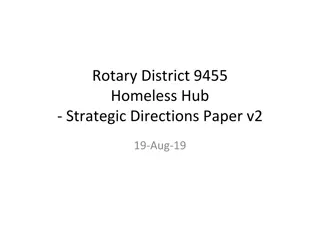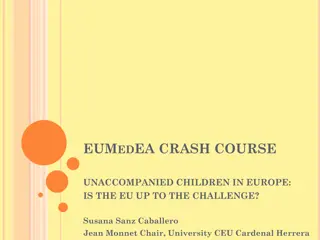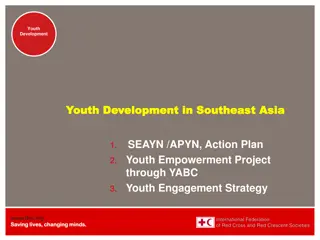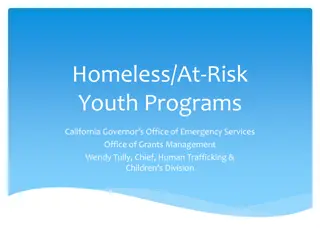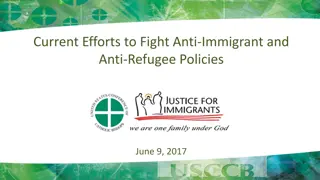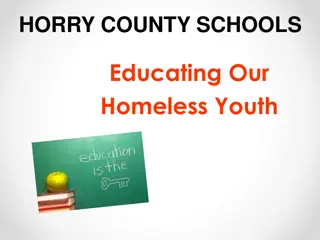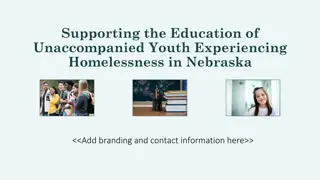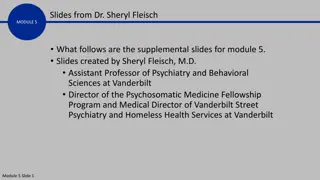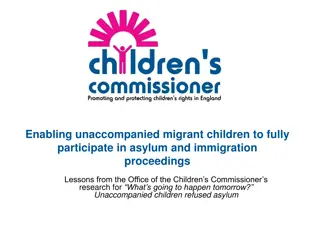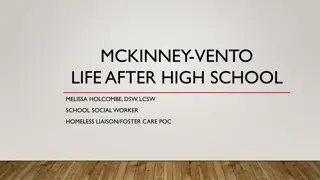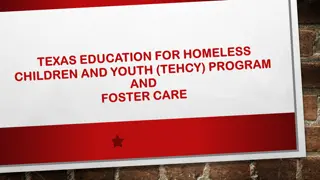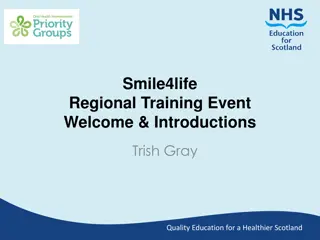Unaccompanied Homeless Youth Survey Report
The Unaccompanied Homeless Youth Survey Report provides insights into the needs and challenges faced by homeless and unaccompanied youth, emphasizing the importance of targeted support and coordination of services. The report highlights key statistics and definitions related to homeless youth, aiming to raise awareness and promote effective solutions for this vulnerable population.
Download Presentation

Please find below an Image/Link to download the presentation.
The content on the website is provided AS IS for your information and personal use only. It may not be sold, licensed, or shared on other websites without obtaining consent from the author.If you encounter any issues during the download, it is possible that the publisher has removed the file from their server.
You are allowed to download the files provided on this website for personal or commercial use, subject to the condition that they are used lawfully. All files are the property of their respective owners.
The content on the website is provided AS IS for your information and personal use only. It may not be sold, licensed, or shared on other websites without obtaining consent from the author.
E N D
Presentation Transcript
Unaccompanied Homeless Youth Survey: DRAFT Final Report April 8, 2015
The Homeless Youth Task Force (HYTF) is a standing committee of the County of San Bernardino Interagency Council on Homelessness. Formed in 2010 by Children s Network to investigate the needs of homeless and unaccompanied youth, a distinct and vulnerable population in need of intensive, developmentally appropriate, targeted support. Homeless Youth Task Force
The HYTF seeks to raise awareness on the issue of child and youth homelessness, promote programs, reduce barriers to services, and coordinate efficient and effective services. Homeless Youth Task Force
HUD A homeless person is an individual without permanent housing whom may live on the streets; stay in a shelter, mission, single room occupancy facilities, abandoned building or vehicle; or in any other unstable or non-permanent situation, including doubled-up. Homeless Youth Definitions
The California Department of Education defines homelessness as the term homeless children and youth mean individuals who lack a fixed, regular, and adequate nighttime residence living in motels, shelters, cars, public spaces, bus or train stations, etc. Homeless Youth Definitions
According to the National Alliance to End Homelessness there are 45,205 unaccompanied homeless youth, both sheltered and unsheltered, up through age 24 in 2015. National Problem
National Alliance to End Homelessness, Homelessness in America Report (2015) 7.8% of total homeless population are youth. According to HUD, 12% of the total homeless population in California are youth. National Problem
Many youth, whether unaccompanied or residing with friends, and/or family, experience many of the same factors such as poverty, domestic violence, substance abuse, lack of housing stability, mental health disorders that contribute to adult homelessness. Youth homelessness is often characterized through crisis resulting from family instability and breakdown, which result in youth running away from negative environments or through abandonment. Causes of Youth Homelessness
The HYTF administered the first Homeless Youth Survey on April 8, 2015, between the hours of 1-5 p.m., to capture both youth who were still in school and those who were not. Youth who were living on the streets, in a shelter, in a motel, or were couch surfing were counted; and, youth living with a parent, guardian or foster parent. Homeless Youth Survey
The survey was administered by youth (ages 18 to 25) asking homeless youth demographic questions to better understand the populations housing needs. All youth participants received a hygiene kit that included a resource guide from the Office of Homeless Services (OHS) and a $25 gift card to Stater Brothers. Homeless Youth Survey
The HYTF decided to conduct the survey because of discrepancies in defined data elements between HUD and Department of Education McKinney-Vento Act guidelines. In 2014, there were over 36,886 homeless public school students in the County of San Bernardino, but Homeless Youth Survey
Through the HUD-mandated Point in Time Count, only 114 unsheltered and 131 sheltered children and youth were identified countywide. 304 youth were surveyed on April 8, 2015 The three main goals of the survey: 1) more accurately depict the scope of the problem, 2) understand the factors leading to homeless youth, and 3) utilize the data to capture additional resources. Homeless Youth Survey
A 23 question survey was administered to unaccompanied homeless youth. The Survey was implemented in four major areas of the county: Morongo Basin, Redlands, San Bernardino, and Rancho Cucamonga. Teams of three youth volunteers were accompanied by one adult expert. The youth volunteers conducted the Survey. Homeless Youth Survey
304 total surveys were completed 75% resided on the day of the survey at the home of a parent, guardian, foster parent, friend, relative, partner, boyfriend or girlfriend. Approximately 9% of youth resided in temporary, emergency or transitional housing. Over 13% resided outdoors in a public place, abandoned building, or vehicle. Major Findings
When asked how long the youth have been residing in similar places, almost 3 out of 4 noted that they have resided there for months (43%) and/or years (30%). In addition, similarly over 60% of youth noted that they would be able to reside at the same location for 14 days without being asked to leave. Major Findings
1. Develop STAY Centers at each TAY Center Countywide. 2. Develop Transportation Resources. 3. Develop Additional Drop-In Centers 4. Develop an Educational Campaign to Advocate For and Develop more resources. 5. Develop Youth Street Outreach Teams affiliated with the TAY Centers. Draft Recommendations
TAY HOUSING Master Leasing Vouchers (HUD) TAY with own income 6 Rancho TAY in FY 13/14 4 San Bernardino TAY in FY 13/14 Board and Care (Licensed) Interim assistance, SSI or own income 106 TAY served in FY 13/14 Currently serving 43 TAY Emergency Shelter Beds MHSA Housing funded Department of Behavioral Health www.SBCounty.gov
Crisis Residential Treatment (CRT) Program Voluntary CRT Center for TAY ages 18 to 25 in need of higher level of care than outpatient mental health but lower than a psychiatric hospital. Peer Driven 14 Bed Services 24 hours a day, 365 days a year 30 to 90 day stay Co-ed Services include: Individual and Group Therapy Crisis Intervention Medication Support Drug and alcohol counseling/referrals Prevocational preparation Rehabilitation/Recovery (daily living skills) Wellness Recovery Action Plans Prerelease/discharge preparation and planning Department of Behavioral Health www.SBCounty.gov
DBH & TAY Program Funding The TAY System of Care is funded by a combination of Mental Health Services Act (MHSA), Medi-cal Federal Financial Participation and 2011 Realignment funding. One Stop TAY Centers are funded by the MHSA Community Services and Supports (CSS) component. The estimated program MHSA expenditure for FY 15/16 is $5,795,799. The TAY CRT (The STAY) is funded by the MHSA Innovation (INN) component. The estimated MHSA program expenditure for FY 15/16 is $2,500,000. Department of Behavioral Health www.SBCounty.gov
Lessons Learned & Challenges! Involve stakeholders and keep them involved and invested. Shared Vision between County and Contracts agencies is key. Look for continual reinvention of the program to maintain interest and individualize supports. Create an attractive, youth friendly environment. Foster relationships and bring together child serving systems and cultures to build a sustainable and comprehensive system of care for TAY. Prepare/Increase the number of Housing providers to meet the needs of TAY Population. Department of Behavioral Health www.SBCounty.gov
Locations Mental Health Systems Ontario One Stop TAY Center 316 East E Street Ontario, CA 91764 (909) 983-4466 San Bernardino One Stop TAY Center The STAY (CRT) 780 East Gilbert Street San Bernardino, CA 92415 (909) 387-7194 Victor Community Support Services Victorville TAY Center 14360 St. Andrews Drive, Suite 11 Victorville, CA 92395 (760) 243-5417 Valley Star Community Services One Stop TAY Center 58471 29 Palms Hwy, Suite 102 Yucca Valley, CA 92284 (760) 853-4888 Department of Behavioral Health www.SBCounty.gov
